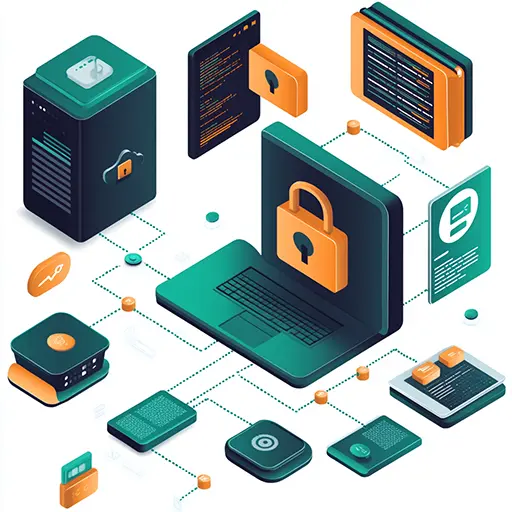1. Understanding Data Security
- Data security is essential for all businesses, ensuring the protection of valuable information from unauthorized access and misuse.
-
Details:
- Definition: Data security involves practices designed to keep digital information safe and accessible only to authorized users.
- Types of Data to Protect: Includes personal data (e.g., customer names, addresses), financial information (e.g., transactions, credit details), and customer data.
2. Common Threats and Vulnerabilities
- An overview of the most common security threats faced by small businesses.
-
Details:
- Phishing Scams: Attackers pose as legitimate institutions to steal sensitive information.
- Malware and Ransomware: Malicious software designed to infiltrate and damage systems, sometimes locking out users and demanding ransom.
- Case Study: A small business successfully recovered from a phishing attack, demonstrating the importance of being prepared.
3: Essential Data Security Practices
- Regular Software Updates: Keep software updated to patch security holes and defend against new threats.
- Strong, Unique Passwords: Use robust, unique passwords for different accounts to prevent unauthorized access.
- Multi-Factor Authentication (MFA): Add an extra layer of security by requiring multiple forms of identification before granting access.
4. Building a Data Security Plan
- How to create a simple, effective security plan tailored for non-technical people.
- Details:
- Identify Data to Protect: Catalog the types of data handled, prioritizing based on sensitivity and impact of a breach.
- Assign Roles and Responsibilities: Define clear roles for managing different aspects of data security within the team.
- Response Plan for Data Breaches: Develop a strategy to contain and mitigate damage in case of a breach, including key contacts.
5. Seeking Expert Help
- When and how to seek professional help to secure your data.
- Details:
- Types of Security Services: Security audits, managed security service providers, and 24/7 monitoring services.
- Cost-Effective Consulting Options: Start with consultations to understand specific needs before committing to services, and look for scalable solutions.
Market Introduction
Imagine you're at a bustling local market, each stall vibrantly displaying its wares - sparkling jewellery, handmade pottery and vibrant textiles. Each stallholder beams with pride, knowing that their little stall is more than just a business; it's a treasure trove of passion and hard work. But what if one day a clever thief slipped unnoticed through the crowd, stealing valuables not from the tables but directly from the owners' pockets? This scene is not far from what happens in the digital marketplace when data security is overlooked.
As an entrepreneur, you put your heart, sweat and maybe even a few tears into building your business. Whether it's a family-run bakery, a boutique consultancy, or an innovative startup, your company's data-customer information, financial records, trade secrets-is as valuable as the merchandise on a market stall. Just as you wouldn't leave your physical storefront unlocked, it's critical to secure your digital presence. This is where the importance of data security comes in, acting as the locks and alarm system of your online business.
In today's digital age, understanding and implementing basic data security measures isn't just smart, it's essential. "Protect Your Business: Data Security Made Simple for Entrepreneurs" aims to demystify the seemingly complex world of cybersecurity and equip you, the non-technical business owner, with the knowledge and tools to effectively protect your digital assets.
Understanding Data Security
At its core, data security is about protection - ensuring that your company's data is safe from unauthorized access, misuse or destruction. Think of it as building a fortress around your castle, where your company's data is king, under constant threat from marauding invaders.
Why it's important: In my early days as a software developer, I witnessed a small online retailer suffer a massive data breach. Hackers stole thousands of customers' credit card details. The aftermath? Devastating. Loss of customer confidence, legal repercussions and a financial hit that took years to recover from. This wasn't just an attack on data; it was an attack on the company's heart and reputation.
Defining data security: Simply put, data security is a set of practices designed to keep digital information safe and accessible only to authorized users. Think of it as having a set of keys to a safe. Only those with the right keys can access the treasures inside - your valuable business data.
Types of data that need protecting:
- Personal data: Just like the personal IDs or addresses you'd keep under lock and key, this includes any information that can identify an individual, such as customer names, addresses and phone numbers.
- Financial information: Similar to the guarded vaults in a bank, this includes your company's financial details, transactions and customer credit information.
- Trade secrets: Think of this as the recipe for Grandma's secret cake or the blueprint for a new product - trade secrets, strategic plans and other confidential information that gives your business a competitive edge.
To make this more relatable, consider a local coffee shop that you might frequent. The owner, Anna, uses a simple spreadsheet to track orders and manage receipts. If her computer were compromised, not only could the financial stability of her business be at risk, but her customers' information could be exposed, leading to identity theft.
By understanding what data security is and recognizing the types of information that need to be protected, you've already taken the first steps towards protecting your business. In the following sections, we'll take a closer look at common threats and the simple, actionable steps you can take to protect your business against them.
Throughout this journey, remember that you are not just protecting data; you are protecting your passion, your customers' trust, and the future of your business.

Common Threats and Vulnerabilities
Understanding the common threats in the digital landscape is like knowing the potential weaknesses in the walls of your fortress. As an experienced team leader and IT professional, I've seen first-hand how even small vulnerabilities can lead to significant breaches that impact businesses far and wide.
Phishing scams: One of the most common threats today is phishing, where attackers pose as legitimate institutions to steal sensitive information. Imagine you receive an email that looks exactly like it's from your bank, asking you to confirm your account details. You click on the link, enter your details and suddenly you've given thieves the keys to your financial kingdom.
Malware and ransomware: These are types of malicious software designed to infiltrate and damage your systems. If phishing is like someone tricking you into leaving your doors unlocked, malware is like them sneaking in through a window you didn't know was open. Ransomware takes this a step further by not only getting in, but locking you out and demanding a ransom to regain access.
Case study: Consider the story of a local bookstore that clicked on a seemingly innocuous link in an email, which installed ransomware on its system. The business was locked out of its sales records and inventory data during the crucial holiday season, resulting in significant financial loss and customer dissatisfaction.
Preventive measures:
- Educate your team on the signs of phishing and enforce a protocol for reviewing unusual requests.
- Install reputable anti-virus software and keep all systems updated to protect against malware.

Essential Data Security Practices
Securing your organization's data doesn't require a degree in cybersecurity. Instead, it's about implementing simple practices that provide a robust defense against most threats.
Regular software updates: Keeping your software updated is like regularly reinforcing the walls of your fortress. These updates patch security holes and harden your systems against new threats.
Strong, unique passwords: Each password should be strong and unique, like a custom-made key that will only fit into its own lock. Using a password manager can help you keep track of these keys securely.
Multi-factor authentication (MFA): Adding MFA is like putting a guard at the gate who requires two forms of identification before letting anyone in. Even if someone steals your key (password), they still need another form of ID to gain access.
Practical example: Let's look at Maria, who owns a boutique marketing company. By implementing MFA on all of her business and personal accounts, she added an extra layer of security that once prevented a potentially disastrous data breach.
By adopting these essential practices, you're not just putting locks on doors; you're installing security cameras, adding double locks, and ensuring that only the right people have access to your valuable assets. Next, we'll discuss how to tie these practices together into a cohesive data security plan that fits your business needs.

Creating a Data Security Plan
Creating a data security plan is like creating a blueprint for a secure fortress. This plan acts as a strategic guide to protecting your organization's vital assets from digital threats. From my experience of leading teams and developing software, I've learned that a clear and tailored plan is not only beneficial - it's essential to maintaining the integrity and resilience of any business.
Identify what data needs protecting:
- Start by cataloging the types of data you handle - personal information, financial details, proprietary business data. It's like taking inventory of all the treasures in your fortress that need to be protected.
- Consider using data classification frameworks to prioritize data based on sensitivity and the potential impact of a breach.
Assign roles and responsibilities:
- Define clear roles for who manages what aspects of data security within your team. Assign a 'data guardian' for each type of sensitive data.
- Regular training and updates can ensure that all team members are aware of best practices and emerging threats.
Have a data breach response plan:
- Develop a response strategy for potential breaches that details the steps to contain and mitigate damage, similar to emergency drills.
- Include key internal and external contacts (such as IT support and legal) who need to be alerted in the event of a breach.
Seek Expert Help
Even the best-laid plans can benefit from expert input. When it comes to securing your business, seeking professional advice is like consulting with master architects and seasoned warriors who specialize in fortifying castles.
Types of security services available:
- Security audits by certified professionals can uncover hidden weaknesses in your digital defenses.
- Managed security service providers can monitor your systems 24/7, acting as vigilant sentinels for your business.
Cost-effective security consulting options:
- For small businesses, it's often practical to start with a consultation to understand your specific needs before committing to expensive services.
- Look for professionals who offer scalable solutions so you only pay for the level of protection you really need.
By understanding when to seek professional help and what options are available, you can ensure that your organization's data security is not just a DIY project, but a professionally supported fortress. This proactive approach not only protects your business, but also builds trust with your customers by demonstrating your commitment to protecting their data.
This strategic framework will guide you in creating a robust defense against digital threats, allowing you to focus more on growing your business and less on worrying about potential cyber-attacks.
Conclusion
As we conclude our guide, "Protect Your Business: Data Security Made Simple for Entrepreneurs", it's clear that securing your digital domain is not an optional extra - it's a critical component of modern business management. Just as you wouldn't leave the physical doors to your business wide open at night, the same care and attention should be given to securing your digital assets.
A summary of the key points:
- Understanding data security: It's about building a fortress around your company's valuable data and protecting it from unwanted intruders.
- Common threats and vulnerabilities: hreats such as phishing and malware can prevent most breaches.
- Essential data security practices: Simple steps like regular updates, strong passwords, and multi-factor authentication will significantly strengthen your defenses.
- Create a data security plan: A detailed plan will help you and your team respond quickly and effectively in the event of a breach.
- Get expert help: Sometimes, calling in the cavalry - professional security services - can make all the difference in bolstering your digital defenses.
Start today by taking one simple step: review your current passwords and update them if necessary. Schedule a consultation with a data security expert to evaluate your current security measures and identify areas for improvement. Remember, the goal isn't to create an impenetrable fortress overnight, but to continually strengthen your defenses as your business grows.
Every step you take towards better data security not only protects your business, but also builds deeper trust with your customers. They'll know that their data, like your products or services, is in safe hands. This commitment to security isn't just about preventing loss; it's about proactively contributing to the ongoing success and reputation of your business.
Digital Vantage team
Konrad Barejko, your business partner
